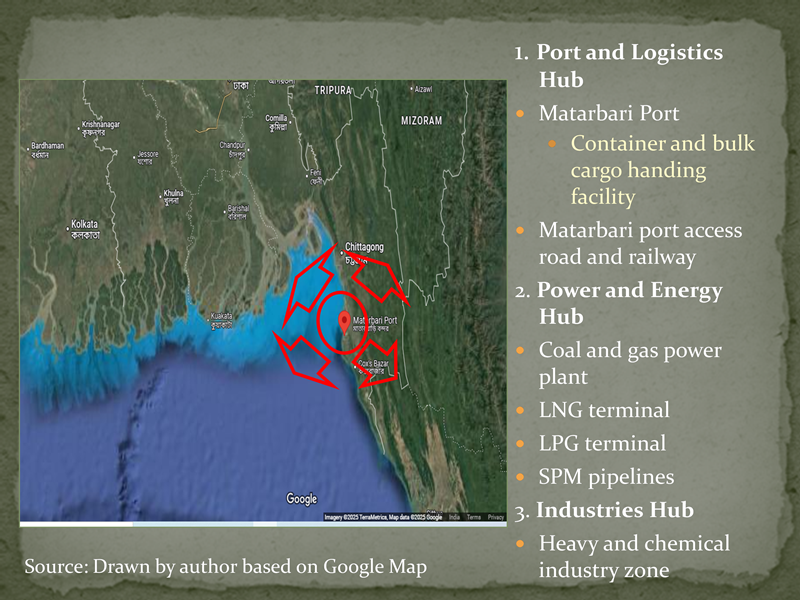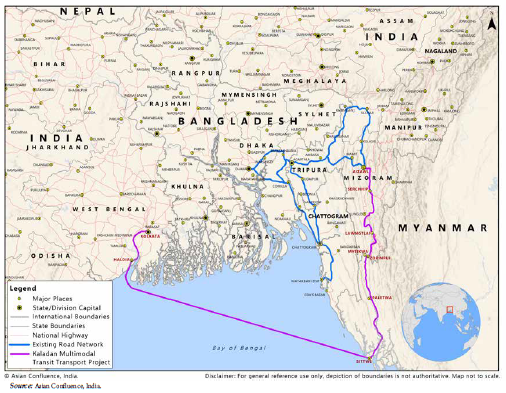レポート・報告書
アジ研ポリシー・ブリーフ
No.225 Matarbari Port and Opening of New Multi-modal Connectivity Corridors
Prabir De
PDF (686KB)
- Bangladesh government is developing a deep sea port at Matarbari with Japanese assistance. The DSP is likely to be operational in 2026. This port is going to handle both container and bulk cargoes.
- The DSP is going to be a regional hub for industrial value chain connecting Northeast India, Bhutan and Nepal. India and Bangladesh would mutually benefit from the development of the Matarbari DSP and the economic zone.
- Reinforcing Matarbari-NER multimodal connectivity will not only foster greater integration of the region but also bolster regional connectivity and growth.
Introduction
Bangladesh government is developing a deep sea port (DSP) at Matarbari with Japanese assistance. The Chittagong Port Authority (CPA) is one of the development (equity) partners. The objective of the Project is to strengthen the port logistics capacity of Bangladesh by constructing a DSP at Matarbari, thereby contributing to acceleration of logistics with neighboring countries. A DSP is a must for the growth of the Bangladesh economy, particularly to support Bangladesh’s elevation to the developing world from 2026 onward when the 1st phase of the Matarbari DSP is likely to be operational.
The Project
Japan, the most-trusted development partner of Bangladesh, has identified the development of the Matarbari DSP as “The Bay of Bengal Industrial Growth Hubs (BIG-Hubs)” in which Japan is expected to invest more than US$ 25 billion over years. This project is central to Japan’s Bay of Bengal Industrial Growth Belt (BIG-B) initiative. Not only port facility, Japan is also developing an economic zone comprising power plants (coal and gas-based), LNG terminal, heavy industries, township, tourism, to mention a few. Designed by the JICA, the DSP is a part of the Moheshkhali-Matarbari Integrated Infrastructure Development Initiative (MIDI), which is an ambitious and futuristic infrastructure project for Bangladesh (Figure 1). The DSP is going to handle both container and bulk cargoes. This port will be able to accommodate 8,000-10,000 container ships per annum. Matarbari DSP is expected to attract FDI, particularly export-oriented businesses. The DSP, having the ability to host any kind of ship, has the potential to become a regional hub for industrial value chain connecting Bhutan, Nepal, India (read, North East India through Tripura).
Enhanced Economic Linkages
Japan has been an active development partner of Bangladesh and India to foster greater integration of the Bay of Bengal region by undertaking connectivity projects. Several recent developments in India, Japan and Bangladesh have underscored the increasing convergence of interests between them. Matarbari DSP is going to play a vital catalytic role in strengthening the emerging trilateral relationship. Figure 2 illustrates a quick overview of the linkages between the DSP and the sub-region.
Figure 1: Matarbari DSP

NER’s Economic and Trade Linkages
The NER of India consisting of the states of Arunachal Pradesh, Assam, Manipur, Meghalaya, Mizoram, Nagaland, Tripura and Sikkimis a services-driven economy. The NER is endowed with not only vast natural resources such as oil, natural gas and hydropower but also an agro-climatic conditions that has been
Figure 2: Matarbari DSP and Multimodal Connectivity

https://www.asianconfluence.org/pdf/1691901670Chapter-5.pdf
helping the region to grow the country’s precious agro-forest products. Three NER states, namely, Tripura, Meghalaya and Mizoram share international border with Bangladesh. Tripura, which has longest border among the NER states, has 8 land customs stations and 2 Integrated Check Posts (ICPs) with Bangladesh, dealing trade, vehicles and passengers. India’s trade through 2 ICPs in Agartala and Saturkandi was about US$ 16 million in 2023. Coal, orange, pomegranate, grapes, apple, dry fish, arjun flower (grass broom), are major exported items to Bangladesh through these ICPs. While food items, soft drink, plastic, household goods, waste cotton, crushed stone, float glass, stone chips, cement, fish edible oil, plastic item, small agricultural machinery are the major import items from Bangladesh.
Bangladesh’s Economic and Port Linkages
At present, Bangladesh has 13 operational land ports, of which 12 are located at land and inland water boundaries with India. These land ports are situated in borders facing 4 Indian states, namely, Assam, Meghalaya, Tripura and West Bengal. Out of the 12 land ports, 7 are located in West Bengal, 2 each are located in Meghalaya and Tripura and 1 in Assam. Nearly 30 per cent of land-based trade between India and Bangladesh takes place through Petrapole-Benapole. Besides, Bangladesh has 9 major sea ports, of which Chattogram and Mongla handle ocean-going vessels.
Expected Opportunities
Both India and Bangladesh have been making efforts to improve the multi-modal connectivity through the NER for expediting the movement of goods and services. The Government of India has been working on a multi-modal transport hub at Sabroom. An ICP has already been set up here. Sabroom is also well-connected with the rest of NER and India through rail and road andhas the potential to become a vibrant logistics and industrial hub. Widening the scope of Agreement for Chattogram and Mongla Ports (ACMP) agreement and the Protocol on Inland Water Transit and Trade (PIWTT) protocol for third country trade is imperative for enhancing multimodal connectivity. Opening of Chattogram port as transshipment port for India’s NER will strengthen the confidence of business people as well as bilateral ties between the two countries. Access to Matarbari DSP will be a phenomenal step in relieving the NER’s land-locked status and also adding an alternative connectivity route. It is anticipated to boost growth and enhance maritime connectivity and trade because the facility is predicted to significantly reduce travel time and distance.
Challenges
There are several challenges and barriers in developing India’s NER connectivity with Matarbari DSP in Bangladesh. These include inadequate infrastructure at border checkpoints, which is one of the biggest barriers to trade, inadequate road connectivity and telecommunication facilities at border transit points and banking and other financial networks, etc. hinder border connectivity. The basic constraints in terms of customs procedures are the lack of efficient customs operations, including lack of transparency of procedures for inspection, informal payments, and inadequate preparation of customs documents, among others. Both Bangladesh and NER also are not fully equipped with digital trade facilitation measures at the land ports. Multiple handling of goods is another common challenge. Border ports, particularly at the Bangladesh side are required modern and spacious warehousing, adequate passenger terminals and facilities, storage space for quarantined goods, to mention a few.
Way Forward
In conclusion, reinforcing Matarbari-NER multimodal connectivity will not only foster greater integration of the region but also bolster regional connectivity and growth. A connected region is prerequisite for an effective utilization of trade-led growth model. By addressing the shared challenges and increasing the overall attractiveness of the Bay of Bengal region, both India and Bangladesh would mutually benefit from the development of the Matarbari DSP.
(Prabir DE/ Research and Information System for Developing Countries (RIS), New Delhi)
The views expressed in the document are those of the author(s) and neither the Institute of Developing Economies nor the Japan External Trade Organization bears responsibility for them. ©2025 Prabir De


